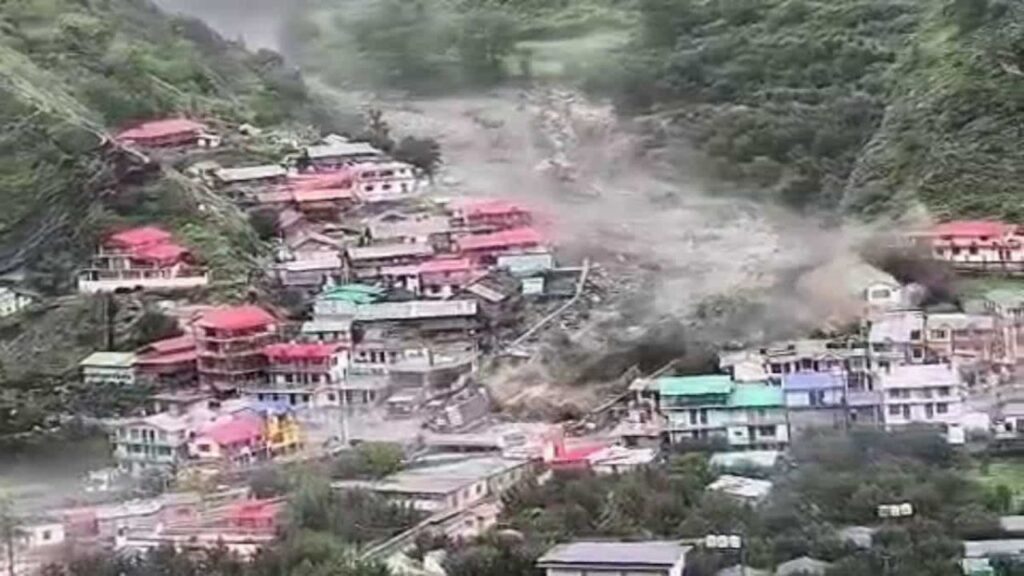The flash floods that ravaged Dharali’s markets in Uttarkashi in August, burying them under 40–60 feet of boulders and debris, marked yet another chapter in the Himalayas’ escalating cycle of disasters. Far from an isolated incident, the Dharali catastrophe reflects the predictable consequences of disregarding climate science and ecological limits.
Uttarakhand, a state long accustomed to nature’s volatility, is reeling from the combined impacts of extreme weather, unchecked development, and environmental degradation. The tragedy underscores a critical truth: human actions are intensifying the fragility of the Himalayan ecosystem, with profound consequences for communities and landscapes.
From mid-June to August, Uttarakhand recorded 973.1 mm of rainfall, 15% above the seasonal average, with Bageshwar district facing an extraordinary 220% excess. These extreme weather patterns, driven by climate change, are no longer exceptions but a recurring reality.
Over the past eight years, Uttarakhand has faced 18,464 natural disasters, resulting in 3,554 deaths, nearly 6,000 injuries, and economic losses in the billions. The Himalayas, geologically young and inherently unstable, are increasingly vulnerable to torrential rains and glacial melt. The Dharali floods, triggered by intense rainfall, highlight how human interventions are compounding these natural risks.
Decades of unsustainable development have deepened the Himalayas’ fragility. The 2013 Kedarnath floods, which claimed thousands of lives, led to the construction of embankments and mitigation structures, but these measures have proven inadequate.
Villages once confined to stable slopes now encroach onto debris-flow fans and riverbeds—areas prone to flooding during heavy rains. Forests have been cleared for concrete jungles, while highways, hotels, and hydropower projects have proliferated in ecologically sensitive zones, choking rivers and destabilising slopes. When torrential rains strike, as they did in Dharali, the mountains unleash their fury, reclaiming spaces altered by human ambition.
A more insidious threat looms over the region which is the Glacial Lake Outburst Floods (GLOFs). The Himalayas are home to over 7,500 glacial lakes, with at least 190 classified as high-risk due to accelerated glacial melt caused by global warming. These lakes, perched above populated valleys, pose a catastrophic risk of bursting and sending torrents of water downstream.
Uttarakhand, alongside Himachal Pradesh, Sikkim, and Arunachal Pradesh, faces heightened vulnerability. The National Disaster Management Authority (NDMA), reflecting on the 2023 Himachal Pradesh floods, identified climate change, unregulated construction, and deforestation as key drivers of escalating risks. Despite these warnings, development projects continue to encroach on unstable terrains, prioritising short-term economic gains over long-term safety.
The NDMA has called for urgent climate-adaptive measures, but implementation remains inconsistent. The Dharali floods highlight the need for a paradigm shift like stricter regulations on construction in flood-prone areas, large-scale reforestation to stabilize slopes, and investment in early warning systems to protect vulnerable communities. Community preparedness programs and sustainable land-use policies are essential to mitigate risks. Cement and concrete cannot tame the Himalayas; only respect for ecological boundaries and proactive planning can prevent further disasters.
The Dharali tragedy is a microcosm of a broader Himalayan crisis, one with implications for all of India. The mountains, a source of cultural, ecological, and economic wealth, are issuing a stark warning: disregard for nature invites catastrophe.
Continuing on the current path risks more disasters like Dharali, Kedarnath, and Sikkim. Climate-adaptive strategies, grounded in science and ecological wisdom, offer a way forward. The Himalayas have endured decades of exploitation, but their resilience is waning.

















